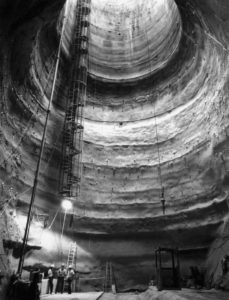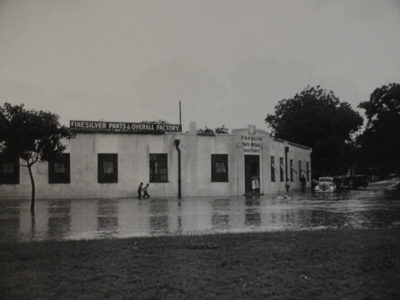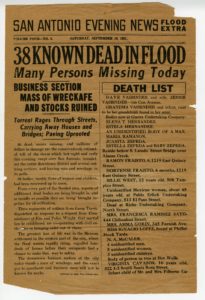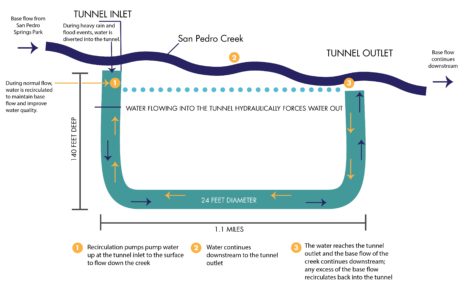Engineering, technology, and great labor were needed to protect the city from periodic deluges.
NATURE NURTURES OUR COMMUNITIES, but it can also cause great destruction. This creek, that served as the cradle of first settlement in 1718 together with its tributary streams on San Antonio’s west side, caused heavy loss of life and property, particularly as the city grew in the 1800s and 1900s. Early efforts to remedy flooding by widening and straightening the creeks altered their age-old natural appearance but helped to control devastating flood waters. By the late 1900s, the San Antonio River Authority and United States Army Corps of Engineers determined that the most efficient and affordable way to protect downtown San Antonio from flooding would be to construct underground bypass tunnels on both the San Antonio River and San Pedro Creek.
The San Pedro Creek tunnel was first to be built. Begun in 1987, the tunnel was completed in 1991. In times of deluge, raging waters enter the tunnel at the inlet shaft near here, plummet 140 feet into a 24-foot-diameter tunnel, then surge forward over a mile to an outlet at Guadalupe Street, south of downtown. Flood waters then emerge into the surface channel that courses turbulently downstream to the creek’s confluence with the San Antonio River.
Both the San Pedro Creek and San Antonio River flood control tunnels were constructed using a boring machine or “mole.” The mole was assembled underground and bored from the outlet shaft upstream to the inlet shaft. The tunnels were lined with precast concrete panels as the mole advanced. This photograph shows the outlet shaft for the San Pedro Creek tunnel.
The flood of September 1921 caused significant loss of life and damage in both the downtown area and neighborhoods adjoining the river and west side creeks. Torrents of water overflowed the banks, destroying commercial buildings and washing away houses. Of the 51 confirmed deaths, all but four occurred along the San Pedro, Alazán, and other west side creeks.
The flow of San Pedro Creek remains in its surface channel under normal conditions. However in times of flooding, excess water is diverted into an underground tunnel to bypass the heavily developed downtown area. On the other hand, during dry periods when springs feeding the creek slow or cease flowing, water pumped out of the tunnel at its upstream end flows downstream through the surface channel, then returns to the tunnel at its outlet shaft to once again be recycled.




